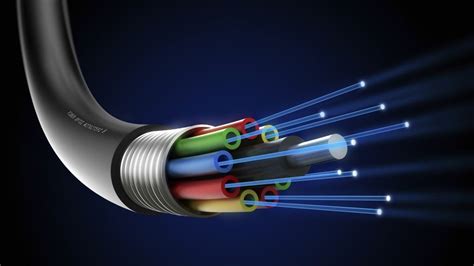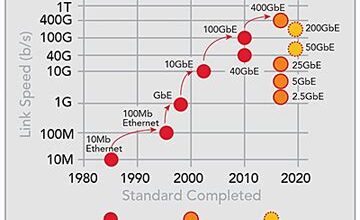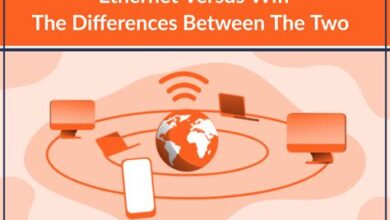The Role of Fiber Optic Ethernet in High-Speed Connectivity

This blog post explores the role of Fiber Optic Ethernet in today’s high-speed connectivity landscape. It begins with an introduction to Fiber Optic Ethernet technology, highlighting its importance in modern networks. We then delve into exploring the role of this technology, discussing its capabilities and advantages. A comparison between Fiber Optic Ethernet and traditional copper cables reveals the superior performance of fiber optics. Finally, the article looks at future trends shaping Fiber Optic Ethernet and provides actionable steps for businesses looking to adopt this advanced networking solution.Okay, I will create a section for the article The Role of Fiber Optic Ethernet in High-Speed Connectivity focusing on The Role, with the structure and requirements you specified. html
Understanding Fiber Optic Ethernet: An Introduction To Connectivity
Fiber optic Ethernet has revolutionized data transmission, offering unparalleled speed and reliability compared to traditional copper-based systems. This technology utilizes light to transmit data through thin strands of glass or plastic, resulting in significantly higher bandwidth and lower latency. Understanding the role of fiber optic Ethernet is crucial for businesses and individuals seeking to optimize their network infrastructure for demanding applications and increasing data needs.
One of the primary reasons for the widespread adoption of fiber optic Ethernet is its ability to support high-bandwidth applications. Activities such as video conferencing, cloud computing, and large file transfers require substantial data throughput, which fiber optic cables can easily handle. The increased bandwidth translates into faster download and upload speeds, improved application performance, and a smoother overall user experience.
| Feature | Fiber Optic Ethernet | Copper Ethernet |
|---|---|---|
| Bandwidth | Up to 100 Gbps and beyond | Up to 10 Gbps |
| Distance | Up to 40 km without signal degradation | Limited to 100 meters |
| Interference | Immune to electromagnetic interference (EMI) | Susceptible to EMI |
| Security | More secure, difficult to tap | Less secure, easier to tap |
Furthermore, fiber optic Ethernet offers enhanced security features. Since fiber optic cables do not emit electromagnetic radiation, it is much more difficult for unauthorized parties to intercept the data being transmitted. This makes fiber optic networks a preferred choice for organizations that handle sensitive information and require a high level of data protection. In contrast, copper cables are more vulnerable to tapping and eavesdropping, posing a greater security risk.
The reliability of fiber optic Ethernet is another significant advantage. Fiber optic cables are less susceptible to signal degradation over long distances compared to copper cables. This means that data can be transmitted across greater distances without the need for repeaters or amplifiers, reducing the complexity and cost of network infrastructure.
- Key Benefits of Fiber Optic Ethernet
- Higher Bandwidth: Supports faster data transfer rates for demanding applications.
- Lower Latency: Reduces delays in data transmission, improving real-time performance.
- Greater Distance: Transmits data over longer distances without signal loss.
- Immunity to Interference: Unaffected by electromagnetic interference, ensuring reliable data transmission.
- Enhanced Security: Provides a more secure environment for sensitive data.
- Increased Reliability: Less susceptible to signal degradation, resulting in consistent performance.
In conclusion, the role of fiber optic Ethernet in modern connectivity cannot be overstated. Its superior performance, security, and reliability make it an essential technology for businesses and individuals seeking to optimize their network infrastructure for the demands of the digital age. As bandwidth requirements continue to grow, fiber optic Ethernet will play an increasingly important role in enabling high-speed, reliable data transmission.
Exploring The Role Of Fiber Optic Ethernet Technology
Fiber optic Ethernet technology has revolutionized data transmission, offering unparalleled speed and bandwidth compared to traditional copper cables. Its ability to transmit data as light signals through glass or plastic fibers makes it less susceptible to electromagnetic interference and signal degradation. This makes it ideal for applications requiring reliable, high-speed connectivity over long distances. Understanding its role involves looking at its advantages, disadvantages, and the various applications it serves.
Fiber optic Ethernet is rapidly becoming the standard for many modern networks, especially where large amounts of data need to be transferred quickly and reliably. As businesses and individuals rely more on data-intensive applications, the need for faster and more stable connections is essential. Fiber optic Ethernet meets this demand by providing a robust solution that supports current and future networking needs.
| Feature | Fiber Optic Ethernet | Copper Ethernet |
|---|---|---|
| Bandwidth | Up to 100 Gbps and beyond | Up to 10 Gbps |
| Distance | Up to 40 km without signal degradation | Limited to 100 meters |
| Interference | Immune to electromagnetic interference | Susceptible to electromagnetic interference |
| Cost | Higher initial cost but lower maintenance | Lower initial cost but higher maintenance |
The implementation of fiber optic Ethernet can significantly enhance network performance, providing a seamless experience for users. However, it’s important to consider the steps involved in deploying this technology to ensure a successful transition. Proper planning, infrastructure assessment, and skilled installation are crucial for maximizing the benefits of fiber optic Ethernet.
Advantages of Fiber Optic Ethernet
One of the main advantages of fiber optic Ethernet is its high bandwidth capacity. Fiber cables can carry significantly more data than copper cables, making them ideal for data-intensive applications such as video streaming, cloud computing, and large data transfers. Additionally, fiber optic cables are less prone to signal degradation over long distances, ensuring reliable performance even across extended networks.
Disadvantages of Fiber Optic Ethernet
Despite its numerous advantages, fiber optic Ethernet also has some disadvantages. The initial cost of installation can be higher compared to copper-based systems due to the specialized equipment and expertise required. Fiber optic cables are also more delicate and can be more difficult to repair than copper cables, potentially leading to increased downtime if not handled properly. However, the long-term benefits often outweigh these initial costs.
Applications of Fiber Optic Ethernet
Fiber optic Ethernet is used in a wide range of applications, from telecommunications and data centers to medical imaging and industrial control systems. In telecommunications, it provides the backbone for high-speed internet and telephone services. Data centers rely on fiber optic Ethernet for fast and reliable data transfer between servers and storage devices. Medical imaging uses the technology to transmit high-resolution images quickly, and industrial control systems use it for real-time monitoring and control of equipment. These are just a few examples of how fiber optic Ethernet is transforming various industries.
To successfully deploy fiber optic Ethernet, a structured approach is necessary. This includes careful planning, proper installation, and ongoing maintenance to ensure optimal performance. By following these steps, organizations can leverage the full potential of fiber optic Ethernet and achieve superior network connectivity.
- Steps to Implement Fiber Optic Ethernet
- Assess current network infrastructure and identify areas for improvement.
- Develop a detailed plan for the fiber optic Ethernet deployment.
- Select appropriate fiber optic cables and networking equipment.
- Ensure proper installation and termination of fiber optic cables.
- Test and certify the new fiber optic Ethernet network.
- Monitor network performance and address any issues promptly.
In conclusion, the role of fiber optic Ethernet is crucial in meeting the growing demands for high-speed connectivity. While there are challenges associated with its implementation, the advantages it offers in terms of bandwidth, distance, and reliability make it a worthwhile investment for organizations seeking to enhance their network infrastructure.
Okay, I will create the Comparing Fiber Optic Ethernet With Traditional Copper Cables section for your blog post, following all the given instructions and HTML requirements. html
Comparing Fiber Optic Ethernet With Traditional Copper Cables
When evaluating network infrastructure, a crucial decision involves choosing between fiber optic Ethernet and traditional copper cables. The Role of each technology significantly impacts network performance, speed, and reliability. Fiber optic cables transmit data as light signals, offering much higher bandwidth and lower latency compared to copper cables, which use electrical signals. This fundamental difference leads to variations in their suitability for different applications and environments.
One of the most significant differences lies in data transmission speed and bandwidth. Fiber optic cables support much higher data rates, often reaching 10 Gbps, 40 Gbps, or even 100 Gbps and beyond, whereas copper cables, such as Cat5e or Cat6, typically support up to 1 Gbps. This makes fiber optic Ethernet ideal for applications requiring high bandwidth, such as data centers, video streaming, and large file transfers. Copper cables, however, can be more cost-effective for smaller networks or shorter distances where extreme bandwidth isn’t necessary.
| Feature | Fiber Optic Ethernet | Traditional Copper Cables |
|---|---|---|
| Data Transmission Speed | Up to 100 Gbps and beyond | Up to 1 Gbps (Cat5e/Cat6) |
| Distance Limitations | Longer distances without signal degradation | Limited to 100 meters for most Ethernet standards |
| Interference | Immune to electromagnetic interference (EMI) | Susceptible to EMI, causing signal degradation |
| Security | More secure; difficult to tap into | Less secure; easier to intercept signals |
Another critical factor is distance limitations. Copper cables experience signal degradation over longer distances, typically limited to 100 meters for Ethernet standards. Fiber optic cables, on the other hand, can transmit data over several kilometers without significant signal loss, making them suitable for large campuses or metropolitan area networks (MANs). Furthermore, fiber optic cables are immune to electromagnetic interference (EMI), ensuring reliable data transmission in environments with high electrical noise, whereas copper cables are susceptible to EMI, which can degrade signal quality.
- Bandwidth Capacity: Fiber offers significantly higher bandwidth.
- Distance: Fiber can transmit data over much greater distances.
- Interference: Fiber is immune to electromagnetic interference.
- Security: Fiber is more secure and harder to tap into.
- Cost: Copper cables are generally less expensive for short distances.
- Durability: Fiber cables are more durable and resistant to environmental factors.
Security is another aspect where fiber optic Ethernet excels. Fiber cables are inherently more secure because it is extremely difficult to tap into them without disrupting the signal, making it immediately noticeable. Copper cables, conversely, are easier to intercept, posing a higher security risk. While the initial cost of fiber optic cabling and equipment may be higher than that of copper, the long-term benefits, including higher bandwidth, greater distance, and improved security, often make it a worthwhile investment for organizations requiring robust and reliable network infrastructure. In conclusion, the choice between fiber optic Ethernet and copper cables depends on the specific requirements of the network, considering factors such as bandwidth needs, distance limitations, environmental conditions, and security concerns.
Future Trends And Actionable Steps For Fiber Optic Ethernet
As technology evolves, so does the landscape of network infrastructure. Predicting the future of fiber optic Ethernet involves considering several key trends. One significant trend is the increasing demand for the role of higher bandwidth to support emerging applications like 8K video streaming, virtual reality, and advanced cloud computing. This demand necessitates further advancements in fiber optic technology to deliver faster and more reliable connections. Another trend is the expansion of fiber optic networks into more rural and underserved areas, bridging the digital divide and providing equitable access to high-speed internet. These advancements will drive innovation and create new opportunities across various sectors.
| Trend | Impact | Actionable Step |
|---|---|---|
| Increased Bandwidth Demand | Necessitates faster data transmission rates and lower latency. | Invest in advanced fiber optic cables and equipment. |
| Expansion into Rural Areas | Bridges the digital divide and promotes economic growth. | Support government initiatives and invest in rural infrastructure. |
| Integration with 5G | Enhances mobile network capabilities and supports IoT devices. | Deploy fiber optic networks to support 5G base stations. |
| Advancements in Technology | Leads to more efficient and cost-effective fiber optic solutions. | Stay updated with the latest technological advancements and adopt innovative solutions. |
The integration of fiber optic Ethernet with other cutting-edge technologies, such as 5G and the Internet of Things (IoT), is also on the rise. Fiber optic networks provide the robust backhaul infrastructure required to support the high data throughput and low latency demands of 5G networks. Additionally, the proliferation of IoT devices necessitates reliable and high-speed connectivity, making fiber optic Ethernet an ideal solution for connecting and managing these devices. The convergence of these technologies will drive further innovation and create new opportunities for businesses and consumers alike.
- Actionable Steps for Adopting Fiber Optic Ethernet
- Assess current network infrastructure and identify areas for improvement.
- Develop a detailed plan for upgrading to fiber optic Ethernet, including budget and timeline.
- Partner with experienced fiber optic installers and service providers.
- Ensure proper training for IT staff on managing and maintaining fiber optic networks.
- Implement robust security measures to protect fiber optic infrastructure.
- Monitor network performance and make necessary adjustments to optimize efficiency.
To effectively leverage the benefits of fiber optic Ethernet, organizations need to take proactive steps. This includes conducting a thorough assessment of current network infrastructure, developing a comprehensive plan for upgrading to fiber optic technology, and partnering with experienced installers and service providers. Furthermore, organizations should prioritize training for their IT staff to ensure they have the necessary skills to manage and maintain fiber optic networks. By taking these actionable steps, businesses can harness the role of fiber optic Ethernet in driving innovation, improving performance, and achieving their strategic objectives.
In conclusion, the future of fiber optic Ethernet is bright, with numerous trends pointing towards its continued growth and importance in the world of high-speed connectivity. By staying informed about these trends and taking proactive steps to adopt fiber optic technology, organizations can position themselves for success in an increasingly digital and connected world. The reliability and capacity offered by fiber optic Ethernet make it a critical component for supporting the demands of modern applications and driving innovation across various industries.



